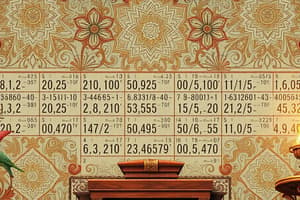Podcast
Questions and Answers
What will be the sale price of an item originally priced at $150 with a 15% discount?
What will be the sale price of an item originally priced at $150 with a 15% discount?
- $132.50
- $135.00
- $145.00
- $127.50 (correct)
How does a markdown differ from a markup in pricing?
How does a markdown differ from a markup in pricing?
- Both terms refer to increases in price.
- A markdown increases the selling price while a markup decreases it.
- A markdown is a decrease in price, while a markup is an increase in price. (correct)
- Both terms refer to decreases in price.
What long-term effect might frequent discounts have on consumer behavior?
What long-term effect might frequent discounts have on consumer behavior?
- Increase brand loyalty.
- Heightened perception of product value.
- Decrease in sales volume overall.
- Price sensitivity may develop. (correct)
Which sale pricing strategy uses discounted prices to encourage bulk purchases?
Which sale pricing strategy uses discounted prices to encourage bulk purchases?
What is an example of psychological pricing?
What is an example of psychological pricing?
How does the perception of value change when discounts are applied?
How does the perception of value change when discounts are applied?
What is the impact of price sensitivity on consumers?
What is the impact of price sensitivity on consumers?
What effect can frequent discounts have on brand loyalty?
What effect can frequent discounts have on brand loyalty?
What is the first step in calculating a sale price with a discount?
What is the first step in calculating a sale price with a discount?
Which of the following represents a potential consequence of discounting?
Which of the following represents a potential consequence of discounting?
What is a common strategy used to reward loyal customers?
What is a common strategy used to reward loyal customers?
How does impulse buying typically relate to discounts?
How does impulse buying typically relate to discounts?
What effect can discounts have on inventory management?
What effect can discounts have on inventory management?
What is a common mistake consumers make regarding sale pricing strategies?
What is a common mistake consumers make regarding sale pricing strategies?
What is the sale price of an item originally priced at $300 with a 10% discount?
What is the sale price of an item originally priced at $300 with a 10% discount?
Flashcards are hidden until you start studying
Study Notes
Calculating Discounts
- Formula: Discount Amount = Original Price × Discount Rate
- Sale Price Calculation: Sale Price = Original Price - Discount Amount
- Example: For a $100 item with a 20% discount:
- Discount Amount = 100×0.20=100 × 0.20 = 100×0.20=20
- Sale Price = 100−100 - 100−20 = $80
Percentages In Pricing
- Percentage Discounts: Commonly expressed as a fraction of the original price.
- Markup vs. Markdown:
- Markup: Increase in price from cost to selling price.
- Markdown: Decrease in price to encourage sales.
- Conversion: Converting between percentage and decimal involves dividing the percentage by 100.
Impact Of Discounts On Sales
- Sales Volume: Discounts can increase the volume of sales, potentially offsetting lower profit margins.
- Perceived Value: Discounts can enhance the perceived value of a product.
- Inventory Clearance: Effective in clearing out excess inventory or seasonal items.
- Short-Term vs. Long-Term Effects: While discounts boost short-term sales, they may lead to price sensitivity in the long term.
Consumer Behavior And Pricing
- Price Sensitivity: Consumers often respond to discounts by increasing purchase quantities.
- Perception of Fairness: Consumers may question the original price if discounts are frequent.
- Brand Loyalty: Heavy discounting can erode brand loyalty if customers expect sales to continue.
Sale Pricing Strategies
- Types of Discounts:
- Seasonal Sales: Timed discounts based on seasons (e.g., holidays).
- Clearance Sales: Reducing prices to clear out old stock.
- Bundle Discounts: Discounting items when purchased together.
- Psychological Pricing: Pricing just below a whole number (e.g., 9.99insteadof9.99 instead of 9.99insteadof10).
- Limited-Time Offers: Creating urgency to encourage immediate purchases.
- Loyalty Discounts: Offering discounts to repeat customers to build brand loyalty.
Calculating Discounts
- Use the formula Discount Amount = Original Price × Discount Rate to determine the amount saved.
- Calculate Sale Price by subtracting Discount Amount from the Original Price.
- Example: A 100itemwitha20100 item with a 20% discount yields a 100itemwitha2020 Discount Amount and a Sale Price of $80.
Percentages In Pricing
- Percentage discounts represent a portion of the original price, expressed in fractions.
- Differentiate between Markup (increase from cost to selling price) and Markdown (decrease to stimulate sales).
- To convert percentages to decimals, divide the percentage value by 100.
Impact Of Discounts On Sales
- Implementing discounts can boost sales volume, potentially compensating for reduced profit margins.
- Discounts can create a higher perceived value for products, making them more attractive to consumers.
- Effectively used to clear out excess inventory or seasonal items, helping manage stock levels.
- Short-term sales increases from discounts may lead to long-term price sensitivity among consumers.
Consumer Behavior And Pricing
- Consumers exhibit price sensitivity, often increasing purchase amounts in response to discounts.
- Frequent discounts may lead consumers to question the fairness of the original pricing.
- Heavy discounting risks undermining brand loyalty as customers might expect ongoing sales.
Sale Pricing Strategies
- Seasonal sales align discounts with specific times of the year, like holidays, to drive sales.
- Clearance sales focus on reducing prices to eliminate outdated or excess inventory.
- Bundle discounts encourage the purchase of multiple items together for a better deal.
- Psychological pricing techniques, such as pricing items at 9.99insteadof9.99 instead of 9.99insteadof10, leverage consumer perception.
- Limited-time offers create urgency, prompting immediate buying decisions.
- Loyalty discounts reward repeat customers, fostering stronger brand loyalty and retention.
Consumer Behavior And Pricing
- Discounts enhance perceived value, motivating consumers to make purchases.
- Price sensitivity varies by product type; consumers generally favor lower prices.
- Significant discounts often trigger impulse buying behaviors.
- Regular discounts can weaken brand loyalty, as consumers may switch for better deals.
Percentages In Pricing
- Discounts are typically expressed as a percentage off the original price.
- Sale Price Calculation Formula:
- Sale Price = Original Price - (Original Price x Discount Percentage).
- Example: A 100itemwitha20100 item with a 20% discount results in a sale price of 100itemwitha2080.
Impact Of Discounts On Sales
- Discounts can significantly increase sales volume when marketed effectively.
- Effective discount strategies need to consider profit margin reductions.
- Discounts aid in managing inventory by clearing excess stock.
- Special promotions can attract new customers, leading to potential repeat business.
Calculating Discounts
- Essential calculation steps include identifying the original price and conversion of percentage to decimal.
- Example Calculation:
- Original Price: $250
- Discount of 15% leads to a discount amount of 37.50,resultinginasalepriceof37.50, resulting in a sale price of 37.50,resultinginasalepriceof212.50.
Sale Pricing Strategies
- Percentage discounts are prevalent in retail due to their simplicity and consumer clarity.
- Buy One Get One (BOGO) deals encourage larger purchases and create a perception of high value.
- Seasonal sales align discounts with holidays/seasons to stimulate purchases during peak demand.
- Limited-time offers create urgency, inducing quicker consumer decisions.
- Loyalty discounts reward regular customers, enhancing brand loyalty and fostering retention.
Studying That Suits You
Use AI to generate personalized quizzes and flashcards to suit your learning preferences.




